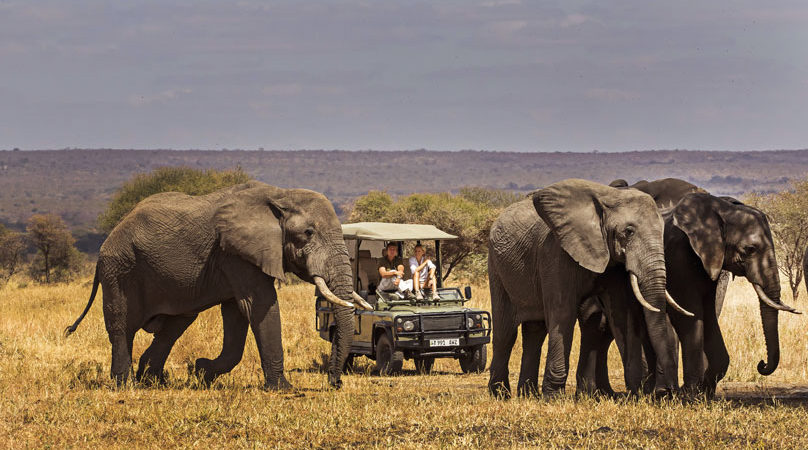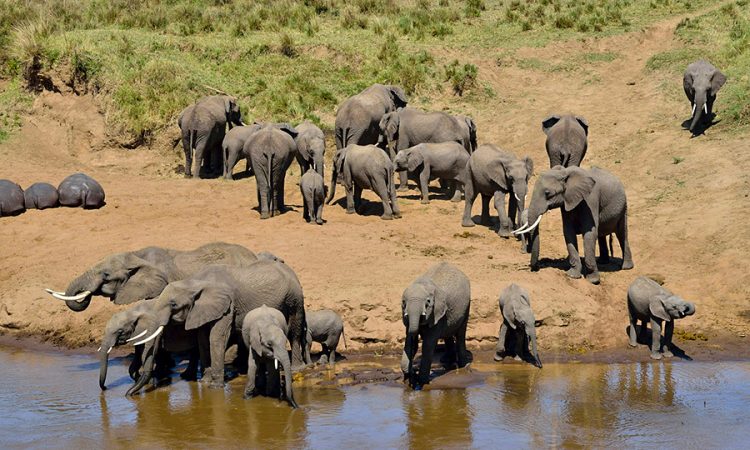A unique national park and one of Tanzania’s must-see locations, Tarangire National Park is situated in the Manyara region, some 118 kilometers from Arusha, the region’s principal city, and about 70 kilometers from Lake Manyara. Tarangire National Park is located on the Northern Safari Circuit and is conveniently located between Lake Manyara, Serengeti, and Ngorongoro Crater, making it an ideal layover location.
The 2,850 square kilometer Tarangire National Park is home to a diverse ecological system, including vegetation, animal life, bird life, and termite molds. The magnificent Tarangire River, which runs through the park and divides it in two, gives the area its name. Tarangire National Park was first established in 1957 as a national reserve and was later designated a national park. The topography of Tarangire National Park is peppered with the well-known sun-blistered termite mounds, grassy savannah plains, and wetlands. Tarangire River, the park’s sole permanent water supply, feeds the ecosystem and park itself. Thousands of animals, including over 3,000 elephants, wildebeests, zebras, impalas, and gazelles, flock to the Tarangire River to drink water, especially during the dry season (June to November). These animals travel to the river in quest of both water and green pasture.
Tarangire National Park is home to 58 species of large mammals that may be easily discovered in different parts of the park. During the dry season (June to November), the area also undergoes an annual elephant migration. Over 3000 elephants migrate into the park in search of green grass and water; this spectacular event is witnessed on the plains of the park and along the Tarangire River as they meander beneath baobab trees. As wildebeests, hartebeests, elands, impalas, zebras, and buffalo swarm into drying lagoons in quest of water, Tarangire National Park also hosts the highest number of species outside the Serengeti environment. Leopards, lions, cheetahs, elands, impalas, wild dogs, antelopes, fringe-eared oryx, grant’s gazelles, vervet monkeys, banded mongoose, olive baboons, larger kudus, and many other animals can be found at Tarangire National Park.
One of Tanzania’s most significant birding regions, Tarangire National Park is home to more than 550 different bird species. Birds in the park typically congregate among wetlands, forests, and the Tarangire River’s banks. These birds include Hoopoes, hornbills, yellow-necked spur fowl, crested francolin, lilac-breasted rollers, stripped swallows, swifts, cordon bleus, owl’s plovers, bee-eaters, starlings, kori bustards, bateleur eagles, steppe eagles, tiny pygmy falcon, white-faced whistling ducks, red-billed teals and many more.
The beautiful Baobab trees, one of the biggest trees on earth and known by a variety of names, are the reason Tarangire National Park is so well-known worldwide. Locally, Baobab trees are referred to as Mbuyu in the Swahili language. They are also known as bottle trees, rat trees, and monkey-bread trees. The entire Baobab tree in Tarangire National Park grows to a height of 30 meters, with trucks reaching 11 meters in diameter, and has a life expectancy of 6000 years. It has an unusually thick robust trunk with stunted root-like branches.
Safari activities to do in Tarangire national park
Game drives
There are five routes that can be utilized for game drives in Tarangire National Park: the Lemiyon route, the Gursi route, the Lamarku route, the western Lake Barungi route, and the Kitibong hill route. The park is home to a large concentration of animals. Game drives in Tarangire national park are offered as morning, afternoon and evening game drive, on this experience you are to spot numerous animals such as leopards, lions, cheetah, elephants, buffaloes, wildebeests, hartebeests, elands, impalas, wild dogs, antelopes, fringe-eared Oryx, grant’s gazelles, vervet monkeys, banded mongoose, olive baboons, greater kudus and many more.

Bird watching
More than 500 different bird species, both migratory and permanent, can be found at Tarangire National Park, making it a great place to go bird watching. In Tarangire national park the best spot for viewing birds are savannah woodlands, swamps along Tarangire River and Lemiyon triangle situated in the northernmost end of the park, birds spotted on this experience include martial eagles, bateleur eagles, long crested eagles, spotted eagle owls, fish eagles, ostriches, great white pelicans, tawny eagles, white-faced whistling ducks, superb starlings, white headed babblers and many more.
Nature walks
The picturesque environment and different vegetation zones of Tarangire National Park make for a wonderful nature walk experience. The park offers nature walks in the morning and evening that last between one and three hours. The magnificent baobab trees, a variety of birds in swamps like hoopoes, hornbills, yellow-necked spur fowl, crested francolin, lilac-breasted rollers, stripped swallows, swifts, and a variety of animals like elephants, antelopes, lions, and many more can all be seen by tourists during this safari experience along the Tarangire River’s banks.
Sightseeing
One of the most memorable safari activities is sightseeing in Tarangire National area, which offers breathtaking views of the surrounding natural environment, including the numerous swamps like Silale Swamp and the majestic Baobab trees that dot the area. A fantastic place to go sightseeing in the park is the 30 square kilometer Silale Swamp, which is home to a variety of wildlife including zebras, gazelles, elephants, and other bird species. Tarangire River, which is encircled by enormous baobab trees and wetlands, is another spectacular site to see in Tarangire National Park.
Cultural tours
The Masai tribal people and their own culture, norms, and traditions are fascinating to discover during cultural trips in Tarangire National Park. On cultural tours, you may learn about the nomadic lifestyle of the Masai people and see them producing beaded necklaces, anklets, earrings, and bangles as well as other local goods. The Masai settlements can be found along the park’s borders and the park itself is located next to a Masai valley. When doing cultural tours, you will come across the Masai people, who have a distinctive way of building their homes that are in circular shapes. They also have a stunning clothing code of colorful, brilliant shukas.
How to get to Tarangire national park
There are many lodging options in Tarangire national park, including luxury, midrange, and budget options. These include Nimali Tarangire tented camp, Acacia Tarangire luxury camp, Sanctuary Swala camp, Lemala Mpingo ridge lodge, Ecoscience Science center and luxury lodge, Tarangire safari lodge, Tarangire Sopa lodge, Ang’ata Tarangire camp, Kikoti tented camp, and Sangaiwe.
Accommodations in Tarangire National Park
The majority of safaris to Tarangire national park originate from Arusha city, and both road and air methods of transportation are used to reach to the park. Tarangire national park is situated on the northern safari circuit and readily visited through routes connecting to Ngorongoro crater and Serengeti national park. Public and private transportation is available from Arusha City to the park, and chartered flights are also available from Arusha Airport to Kilimanjaro International Airport.


